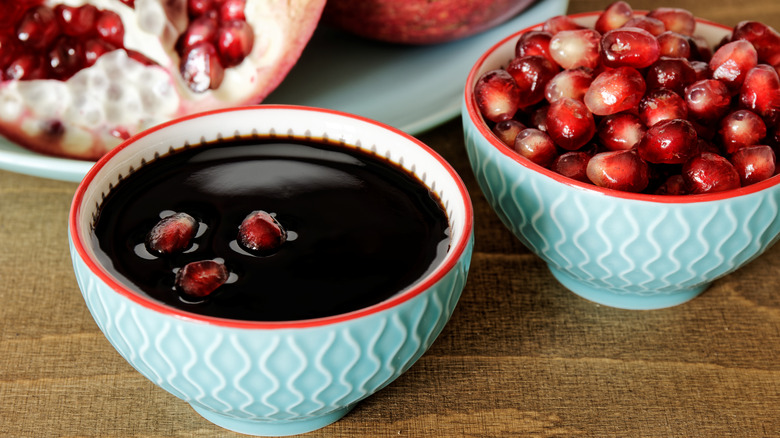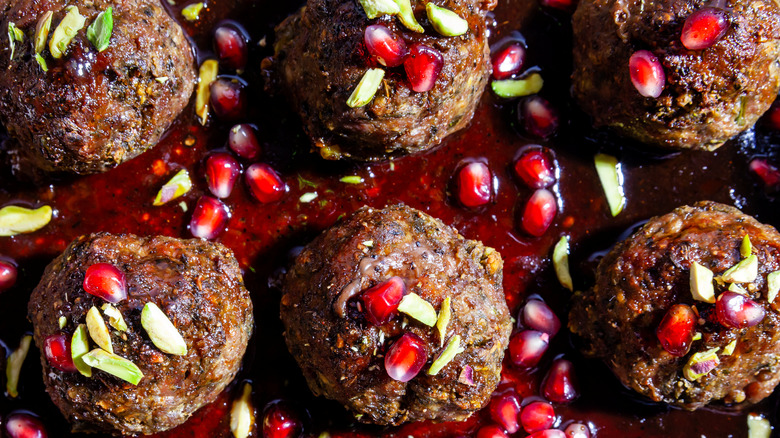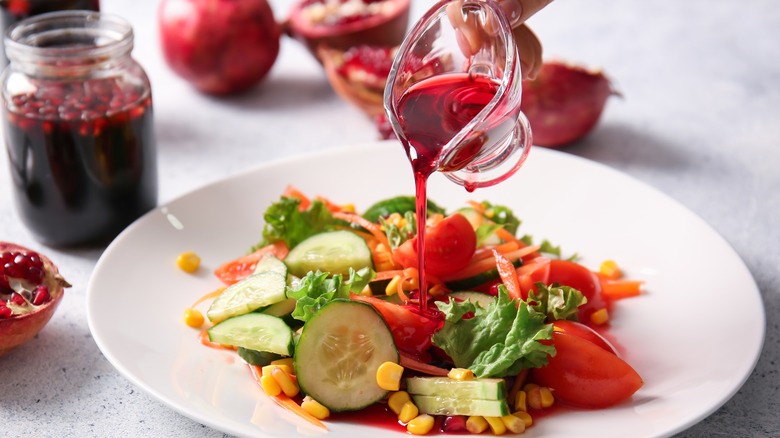The Sweet Facts You Need For Using Pomegranate Molasses
Move over tahini, another old-school Middle Eastern pantry staple is here to share your spotlight. Pomegranate molasses has been a regional favorite for adding a tangy-sweet burst of flavor to all sorts of edible delights for many years. Along with other Middle Eastern ingredients like the aforementioned tahini, Aleppo pepper, and floral rose and orange waters, pomegranate molasses deserves a place in our increasingly global pantries of today.
Pomegranate molasses, also known as pomegranate syrup, is essentially the concentrated juice of pomegranate fruits. It has a pourable viscous consistency, with a dark red, almost brown color. The flavor is a deep fruity sweetness of currants coupled with an almost vinegar-like tartness and astringency. According to celebrated chef Yotam Ottolenghi, "[Pomegranate molasses] can be compared to balsamic vinegar, yet is much fruitier and should be used sparingly."
Traditionally it is used in recipes like the Syrian dishes of muhammara (a nutty, spicy dip), and kabab karaz (saucy lamb meatballs), and also the famous Persian poultry stew fesenjoon. The unique flavor of pomegranate molasses adds a deep richness to these dishes, with a sour undercurrent that helps lift these otherwise heavy flavors.
How to experiment with pomegranate molasses
As with most, if not all ingredients, we encourage you to experiment with pomegranate molasses to see where it can fit into your cooking repertoire. There are a couple of different ways to start. First, you could use it in tandem with other Middle Eastern ingredients to hone in on flavors that already culturally work well together. Drizzle some over a creamy homemade hummus, or use it instead of red wine in this ras el hanout braised chicken legs.
The other way of playing around with pomegranate molasses' flavors is by substituting it in recipes where you would usually use vinegar and/or sweeteners. Its sour-sweet quality can both ground and lift a dish, leaving your dinner guests guessing as to what the secret ingredient is. Think of it as a deliciously unusual meat marinade, or as a swap for the flavors in a homemade vinaigrette to add interest to your salads.
Pomegranate molasses also works wonderfully in desserts as a tangy substitute for syrups. Try it in place of maple syrup in this strawberry granola recipe, or in addition to the honey in this sticky pistachio cinnamon baklava. There are really so many ways to incorporate this unique ingredient into your cooking.
Places to buy and substitution ideas
We've given you a ton of suggestions for how to use pomegranate molasses and your creative juices are buzzing. Where then to get some of this pomegranate molasses for yourself? Any Middle Eastern supermarket is likely to have it on its shelves. If not, Amazon stocks a few brands like Sadaf and Cortas.
If you can't find any in stores or online, there are a few ways you can whip up a substitute. If you're using it as a syrup, balsamic vinegar will do in a pinch. Look for a bright and fruity variety, adding a bit of sugar or lemon juice to adjust the sweetness and tang. If you're not using it as a marinade or in similar applications, you can also substitute pomegranate molasses with pomegranate seeds itself. Whether with fresh or frozen seeds, this will give the necessary flavor of pomegranates, especially if you're using it in salads, cooked into stews, or worked into baked goods.
If you're able to find fresh pomegranate juice, you can simmer it slowly on low heat until it reduces into a thick syrup that coats the back of a spoon. Cranberry juice will also work with this method, though you may need to add a bit of sugar to make up for the lack of sweetness.


